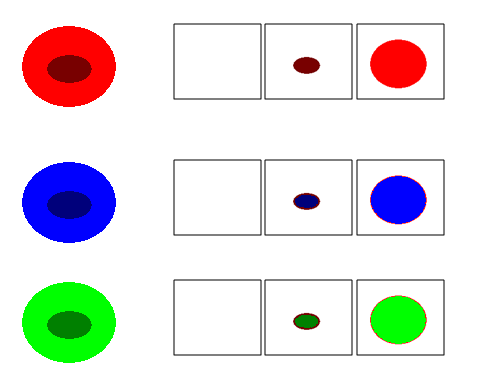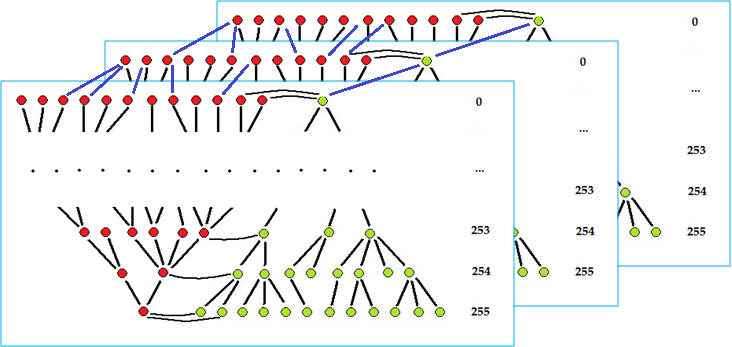This site is being phased out.
Graph representation of topology of color images
Start at Graph representation of topology of gray scale images and Color images.
Contents
What is the topology of a color image?
The RGB color space is $$C = \{ (r, g, b) : 0 ≤ r, g, b ≤ 255 \}.$$ There is a natural partial order on $C$: $$r ≤ r’, g ≤ g’, b ≤ b’ \Rightarrow (r, g, b) ≤ (r’, g’, b’).$$
If only one of the three primary color is changing, the topology is the same as that of the corresponding gray scale image:
Then we recognize objects as darker areas surrounded by lighter background. Similarly, all three colors may be changing producing the same effect of a dark object on a light background. The rule applies to more general situations.
To make this specific, suppose we have a color image as a function $J:[0,N] \times [0,M] → C$, where $C$ is the RGB color space.
If we have any function $P:C → [0,255]$, then the composition $PJ:[0,N] \times [0,M] → [0,255]$ is a gray scale image. Suppose also that $P$ is increasing with respect to the partial order: $$r≤r', g≤g', b≤b' \Rightarrow P(r,g,b)≤P(r',g',b').$$ What this means is that the darker/lighter relationship between pixels is preserved under $P$ but some of it may disappear. In other words, the gray scale of $PJ$ is becoming darker as the color of $J$ is becoming darker.
Two things follow:
- Every darker area surrounded by a lighter background in the gray scale image $PJ$ appears as a darker area surrounded by a lighter background in the original image $J$, for any $P$.
- Every darker area surrounded by a lighter background in image $J$ appears as a darker area surrounded by a lighter background in the gray scale image $PJ$, for some $P$.
Therefore, in order to capture the topology of $J$ one needs to capture the topologies of all possible gray scale images $PJ$, without double counting.
A similar analysis will lead to an even simpler conclusion that in order to capture the topology of $J$ one needs to captures the topologies of all of its possible binarizations (via thresholding), without double counting.
Topology graph of a color image
The nodes of the topology graph are the objects and holes in the thresholded image and there is an arrow from node $A$ to node $B$ if:
- object $B$ has hole $A$, provided $A$ and $B$ correspond to consecutive colors.
- object $B$ has hole $A$, provided $A$ and $B$ correspond to the same color.
- And vice versa.
Each of these slices is the topology graph of the gray scale image obtained from the color image by fixing a value of, say, green and blue and letting red vary. The end result is a box filled with graphs connected with its neighbors.
How to build the topology graph
All pixels in the image are ordered according to the partial order.
- Following this order, each pixel is processed:
- add its vertices, unless those are already present as parts of other pixels;
- add its edges, unless those are already present as parts of other pixels;
- add the face of the pixel.
- At every step, the graph is given a new node and arrows that connect the nodes in order to represent the merging and the splitting of the cycles:
- adding a new vertex creates a new component;
- adding a new edge may connect two components, or create, or split a hole;
- adding the face to the hole eliminates the hole.
For how, see Adding pixels.
Complete analysis
- Same as for gray scale but based on the partial order above
- Threshold the image to create $256 \times 256 \times 256$ binary images.
- Collect all objects and holes in the topology graph, as above.
- Filter noise out if necessary.
- Choose the tips, etc to give the "binary" topology of the image.

